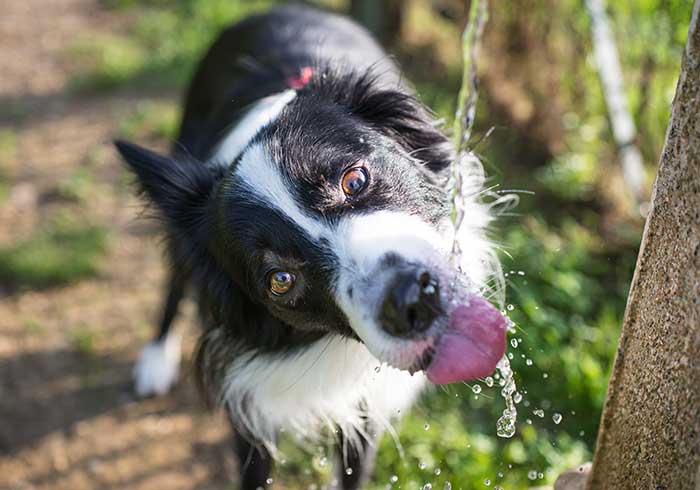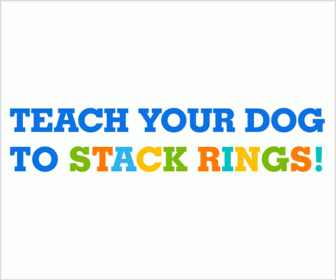You are probably already familiar with the good, old saying that water is life.
Water performs so many functions in our bodies that if we go without it long enough, we will eventually die. Both plants and animals require water to survive.
In dogs, water helps improve their metabolic functions and regulate their body temperature. It also helps flush out toxic substances as well as enhance their sniffing power.
This implies that as a pet owner, you should get very concerned if your furry friend is not drinking enough water. It is not unusual to be caught asking yourself – how long can a dog go without water before getting dehydrated?
Generally, the maximum number of days a dog can go without water is between 3 and 4. However, this could vary depending on a few factors.
In this post, we shall try to delve deeper into some of the reasons that lead to dehydration in dogs, and how to go about it.
Causes of Dehydration In Dogs
The causes of dehydration in dogs can be broadly categorized into environmental, behavioral, dietary and medical.
Environmental causes are basically determined by temperature. A dog that spends too much time in the heat is more likely to suffer dehydration. More on this will be discussed in the following section.
Humidity and altitude are also some key environmental factors that have a direct relationship with dehydration. If you live in high-altitude or humid areas, you are likely to be a victim of dehydration, and so is your dog.

Behavioral causes simply relate to how active the dog is. And as you shall find out, the more active the dog is, the more likely it is to become dehydrated.
Dehydration also has a lot to do with the kinds of food we feed our dogs. There are certain foods that are known to retain less water than others.
Additionally, there are some foods that do not stir thirst, thereby reducing the frequency with which the dog drinks.
As a dog owner, you may also cause dehydration in your dog by making him skip meals. Dogs should eat regularly. Not only will your dog benefit from the water content in its meals. But after eating, it will naturally want to drink water.
Lastly, we have medical triggers. And these triggers could be physiological, psychological or emotional. Either way, they should be taken seriously because if not addressed with the urgency they deserve, the dog could easily succumb to the condition.
Generally, diseases that cause the dog to lose its appetite as well as lose excessive fluids from the body directly lead to dehydration.
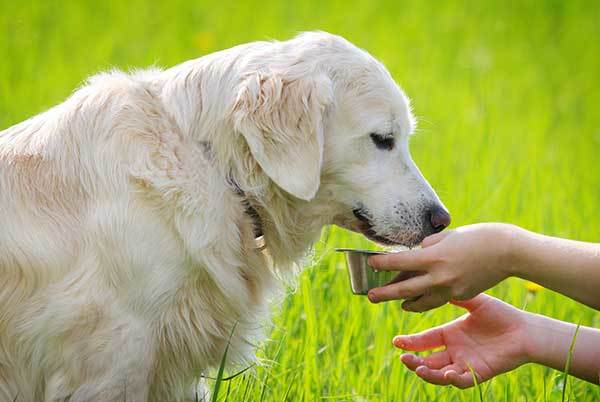
In addition to diseases, injuries to the dog’s mouth or tongue may also prevent it from drinking enough water. And it gets worse if the injury develops into a septic wound.
At times, the dog’s mouth could be sore after a surgical procedure. Which leads us to the question – how long can my dog go without water after surgery?
When recovering from a surgery, your dog might be averse to water as it still feels nauseated. However, you are advised to keep offering water to the dog till it finally accepts to drink. Should the dog fail to drink after a period of 24 hours, then you can consider taking him to the vet.
- WATER CAPACITY: Available in 1/2, 1 or 2 1/2 gallon water capacities
- DRINK ANY TIME: This gravity water station allows you to keep your pet hydrated at all times of the day or night
- STURDY CONSTRUCTION: The reservoir is made of durable plastic and locks in place to help from knock over and spills
Last update on 2025-01-04 / Affiliate links / Images from Amazon Product Advertising API
Psychological factors include the fact that your dog had a traumatic experience that it is still struggling to shake off. For instance, a dog that was just recently neutered or castrated may not drink properly. Worse yet if it associates water with that experience.
Apart from these 4 major causes, the sheer lack of access to water could also lead to dehydration in dogs. When you deliberately take water out of their way, where else would you expect them to get it?
Homeless and abandoned dogs are at greater risk of suffering dehydration since they virtually lack access to a constant supply of water.
The same could also happen due to a change in environment. If you recently moved into a new address, or are traveling with your dog, do not be surprised if it doesn’t readily drink.
Dogs take a significant amount of time to get used to their new environments. In such cases, you may try certain tricks such as having more water bowls.
Having looked at these potential causes, perhaps you are still wondering, can I leave my dog without water during the day?
Well, you can, as the dog is not likely to be dehydrated after going a day without water.
⚠️ Remember that 3 – 4 days is the maximum duration after which you should be very concerned as the dog owner. But even then, the most pertinent question should be – why would you want to subject your canine friend to that kind of agony?
ALSO READ: How Long Can A Dog Go Without Pooping?
Is The Range Of 3-4 Days Cut In Stone?
Absolutely not. While some dogs can go up to 4 days before becoming dehydrated, for others, dehydration might set in in a matter of hours.
There are factors that determine how long a dog will last without taking water. The following are some of these factors:
1. Prevalent Temperature
It is common knowledge that the hotter the weather, the more likely you are to get dehydrated. This principle applies to dogs too.
The logic here is simple. During hotter temperatures, dogs lose a substantial amount of water from their bodies. That water is lost through sweat glands located in their nose and paw pads.
So with hotter temperatures, your dog will not even last up to three days. Instead, he might get dehydrated right on the first day.
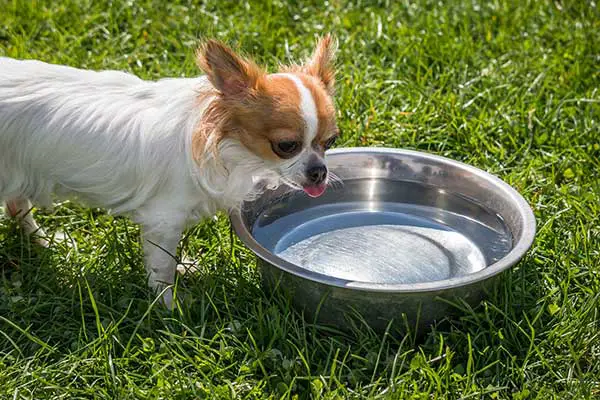
2. Dog Food
Another factor that determines the length of time your dog can go without water is the kind of food you serve it.
Again, common logic dictates that the wetter the food, the more water it adds to the dog’s body. Therefore, dogs that feed on wetter food are likely to last longer without water compared to those that feed on dryer and more solid foods.
In addition to wetness and dryness, there are other aspects of dog food that could escalate dehydration.
For example, dog food that’s low in salt will likely lead to dehydration. Contrary to popular belief, sodium plays two key roles in a dog’s body as far as hydration is concerned.
First, a diet containing sufficient sodium naturally causes sensations of thirst, making the dog drink more water right after feeding. Also, sodium is instrumental in delivering water to body cells.
Therefore, all the water content in a dog’s body is put to good use instead of getting excreted as waste product. This process of water retention delays dehydration. As a caveat, only add sodium in moderation. Usually, around 0.3% is recommended.
Last update on 2024-12-25 / Affiliate links / Images from Amazon Product Advertising API
3. Activity
Playful dogs tend to get dehydrated much faster than the less-active dogs. Well, this should not come off as an indictment against hyperactive dogs.
A playful dog is a healthy dog and as a pet owner, you should be very worried if your dog is the slothful kind. However, when your canine spends so much time frolicking but does not drink much water, then you have all the reasons to be bothered.
4. Dog’s Size
Size has two implications here which include age and weight.
In terms of age, puppies have proportionately lower water content in their bodies compared to adult dogs. That is because unlike adult dogs, pups tend to have a greater requirement for water.

Remember, they have high activity levels and also sweat more profusely, thereby needing constant replenishment of water that is lost from their bodies. But how long can a puppy go without water?
In general, a maximum of a day or two is what it takes for your puppy to get dehydrated.
Also, plump and overweight dogs tend to have comparatively less water content than small and slender ones.
It is important that you first classify your dog properly based on size. You can then determine whether it is getting sufficient water or not.
Pound for pound, small dog breeds like the Chihuahua will drink more often than the big dog breeds like the Great Dane. Like puppies, small dog breeds are known to be more active, hence lose a lot of water compared to the bigger breeds.
5. Underlying Medical Condition
Last but not least, there are certain canine health issues that are directly related to dehydration. Some of these conditions include diabetes, kidney disease and certain types of cancer.
As a matter of fact, any disease that causes vomiting, diarrhea, excessive urination or excessive sweating will most certainly lead to dehydration.
You need not be a trained vet to know that a sick dog requires more water than a healthier one.
Apart from these conditions, it is also important to remember that a dog that has not lost appetite may go longer without water than a dog that’s not eating at all.
Most dog foods already contain a significant amount of water. That is especially true for dog food prepared at a home. When ingested, the water can sustain the dog a bit longer.

How Do I Know My Dog Is Dehydrated?
Symptoms of dehydration in dogs are nearly the same as in humans.
The very obvious signs include dryness in the dog’s nose and gums, as well as a reduced volume of urine. Also, the urine is usually darker in color.
Other signs of a dehydrated dog include the following;
- Lethargy and generalized fatigue.
- Excessive panting.
- Loss of appetite.
- Loss of skin elasticity.
- Sunken eyes.
- Thirst sensation.
- Neurological changes such as confusion, headaches, seizures and general discomfort.
- Stress and depression.
It is important to remember that dogs do not talk. Therefore, always be keen to observe these warning signs and take the necessary remedial measures.
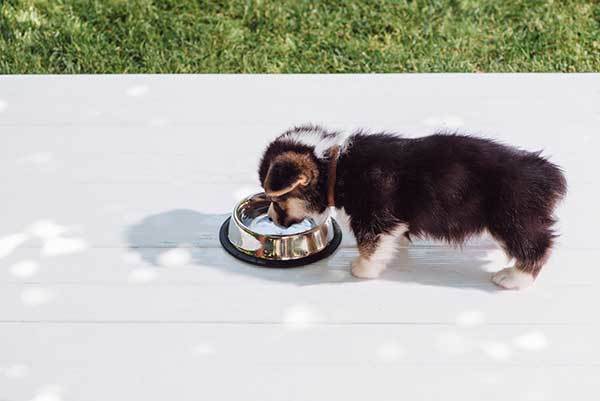
How to Treat Dehydration
Dehydration is a serious condition that should be treated as soon as you notice the symptoms. Usually, dogs react to the idea of water differently depending on the cause of dehydration.
Certain medical conditions are marked with a loss of appetite. And when your dog loses appetite, it will also lose the urge to drink.
So, the first thing is to determine whether the dog will drink or not. If it won’t even taste the water despite how hard you try, perhaps it is time to make a date with the vet.
However, if the dog is showing a desire to drink, you can try rehydrating it by feeding it water in small volumes.
Better yet, you could use oral electrolyte solutions such as Pedialyte. If using Pedialyte, you might want to dilute it with water in the ratio 50:50.

When dealing with a dog that has completely lost its appetite, You can consider giving it beef or chicken broth. And if the dog happens to experience difficulties drinking on its own, you can always use a syringe.
Whatever you do, never attempt to rehydrate your dog using artificial sweeteners, or broth that is seasoned with condiments and spices. This is because aside from causing further dehydration, spicy foods could also interact adversely with your dog’s stomach.
Remember, the last thing you want is diarrhea or vomiting. If the dog is dehydrated but still eats regularly, then consider adding more water to its food.
- 10 Benefits in 1 Daily Treat – PetHonesty’s 10-For-1 Multivitamin chews combine a well-rounded blend of the most essential vitamins and supplements…
- Joint Health with Glucosamine – These natural supplement soft chews have high amounts of glucosamine and other joint support ingredients that reduce…
- Improve Digestion with 1 Billion CFU Probiotics – These one a day dog vitamins contain probiotics and pumpkin, which help keep your dog’s digestive…
Last update on 2024-12-21 / Affiliate links / Images from Amazon Product Advertising API
Preventing Dehydration
Indeed, prevention is better than cure. So instead of expending a great deal of your time, money and energy rehydrating a dog, why not be proactive enough and prevent the condition from happening in the first place?
The most common method to prevent dehydration in a dog is feeding the dog wet food and making sure it drinks enough water regularly.
But how much water is enough water
According to experts, dogs should drink twice as much as they eat. That is because like humans, their bodies generally comprise of 80% water.
Looked at from a different angle, your dog should drink a minimum of one ounce of water for every pound it weighs.
In order to ensure your dog drinks as regularly as it needs to, you should provide sufficient access of water to the dog. You should place water bowls at intervals in the dog’s room and play space.
Also, be sure to replace the water frequently so that each time, the dog only drinks fresh and clean water. For better hygiene, experts recommend water fountains and water dispensers.
Remember that dogs do not gulp down gallons of water in one sitting. Instead, they prefer to drink in sips all day long. Which is why the supply should be consistent.
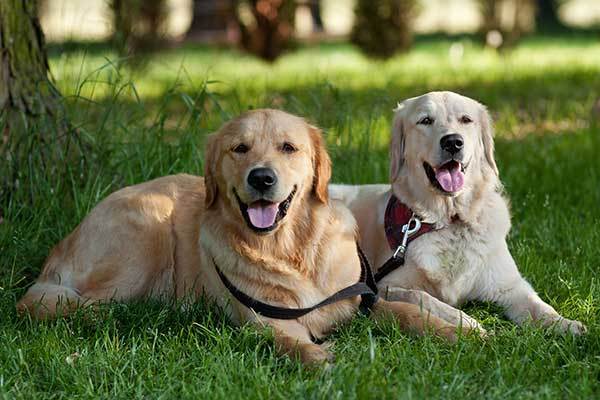
Another method of preventing dehydration is introducing lots of fluids to your dog’s diet. Milk is a special favorite. But first, be sure to establish that your dog is not lactose intolerant.
You can also try chicken and beef broth. Add plenty of broth to your dog food but ensure it is not seasoned in any way.
Above all, regularly check on your dog’s drinking habits and improve where you can. For example, there are dogs that drink only when their owners are around, while others will only drink when they aren’t being watched. Monitor such behavior and respond appropriately.
However, do not be fussy even as you seek to prevent your dog from becoming dehydrated. It is not unusual for dog owners to be found wondering – can a dog go without water for 8 hours?
Essentially, 8 hours is the period you are normally asleep. Therefore, it is perfectly normal for your dog to go without water during this period. You can keep your dog in crate for this duration, assured that it will not get dehydrated in any way.
LEARN ABOUT IT: How To Clean A Dog Without A Bath (9 Tips)
Conclusion
So, how long can dogs go without water? As we have already mentioned, dogs can go up to 3 days without water. Could be longer or shorter depending on a variety of factors.
However, there is no need to wait till dehydration sets in. Not when there are so many ways of preventing the condition. Also, unless the dehydration results from an underlying medical condition, you can successfully treat it.
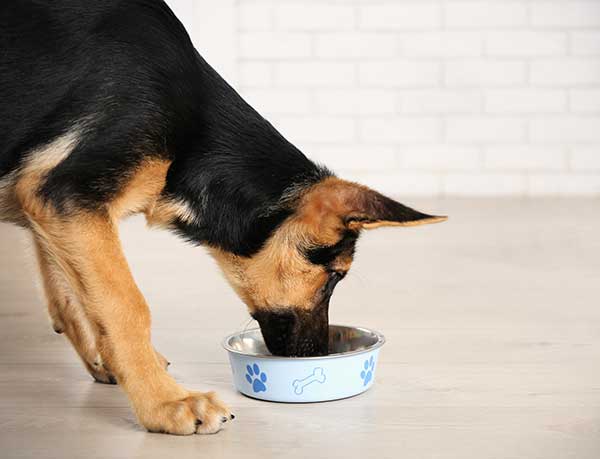
Checkout Our Favorite Dog Products
1. BEST PUPPY TOY
We Like: Snuggle Behavior Toy with Heart Beat & Heat Pack – Ideal toy for new puppies.
2. BEST DOG TRAINING PROGRAM
We Like: Doggy Dan The Online Dog Trainer – Stop any dog problem and raise the perfect puppy with The Online Dog Trainer.
3. BEST FOOD FOR DOGS AND PUPPIES
We Like: Victor Super Premium Pet Food – Ideal for growing puppies and pregnant or lactating females. Also provides sustained energy for sporting dogs and dogs with high physical demands.
4. BEST DOG DNA TEST
We Like: Embark Dog DNA Test – Embark screens for over 250 dog breeds + tests for 170+ genetic diseases including MDR1 drug sensitivity, glaucoma, degenerative myelopathy, and dilated cardiomyopathy, some of the most common adult-onset diseases in dogs.
5. BEST DOG PUZZLE TOY
We Like: Outward Hound Interactive Puzzle Toy – Every dog loves chasing squirrels at the park. The Outward Hound Hide-a-Squirrel Puzzle Toy gives your dog the same feeling as though he was outdoors chasing live squirrels.
6. Best Vacuum to Tackle Pet Hair
We Like: ORFELD Cordless Vacuum – Engineered for homes with pets. With features and tools that dig out dirt, hair and allergens everywhere your pet gets.

